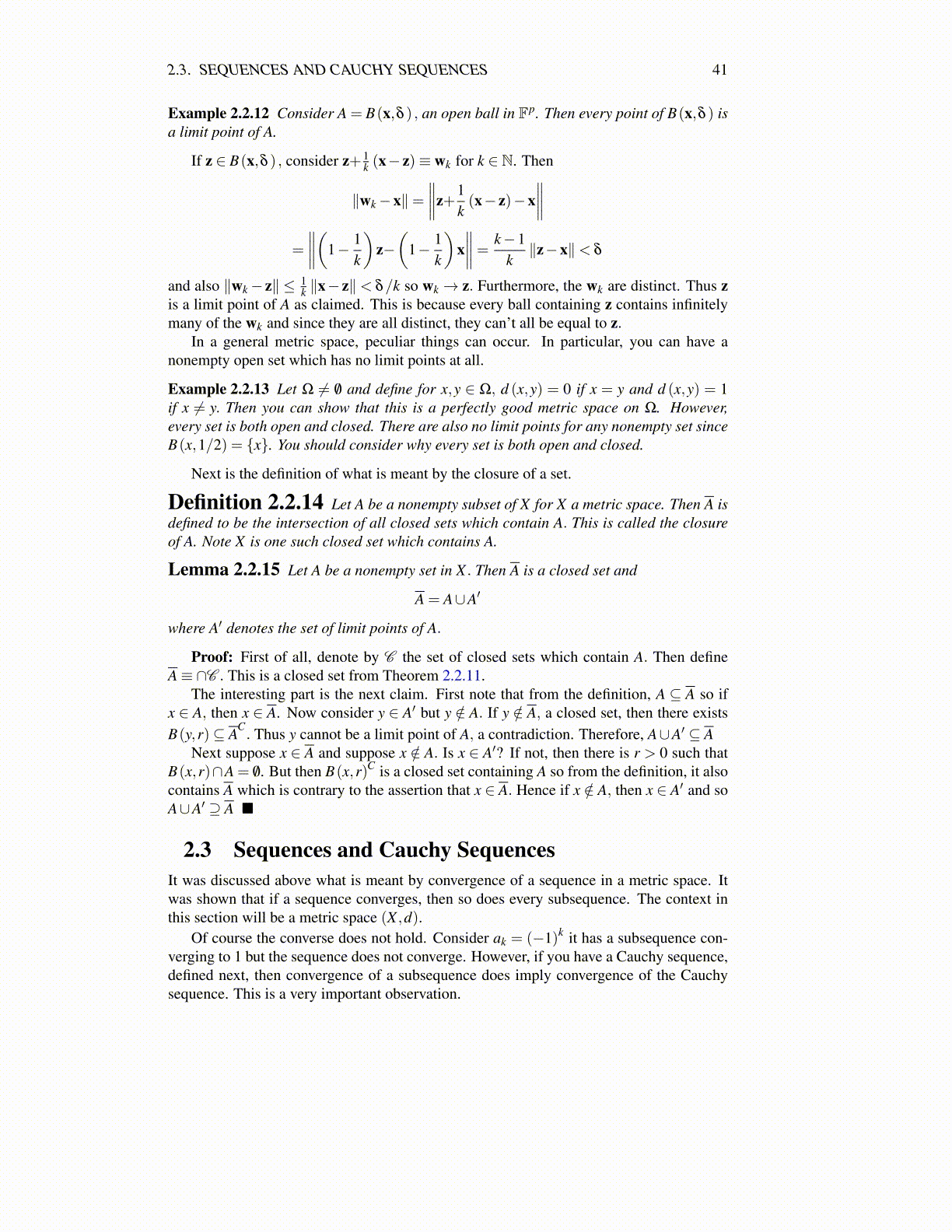
2.3. SEQUENCES AND CAUCHY SEQUENCES 41
Example 2.2.12 Consider A = B(x,δ ) , an open ball in Fp. Then every point of B(x,δ ) isa limit point of A.
If z ∈ B(x,δ ) , consider z+ 1k (x− z)≡ wk for k ∈ N. Then
∥wk−x∥=∥∥∥∥z+
1k(x− z)−x
∥∥∥∥=
∥∥∥∥(1− 1k
)z−(
1− 1k
)x∥∥∥∥= k−1
k∥z−x∥< δ
and also ∥wk− z∥ ≤ 1k ∥x− z∥< δ/k so wk→ z. Furthermore, the wk are distinct. Thus z
is a limit point of A as claimed. This is because every ball containing z contains infinitelymany of the wk and since they are all distinct, they can’t all be equal to z.
In a general metric space, peculiar things can occur. In particular, you can have anonempty open set which has no limit points at all.
Example 2.2.13 Let Ω ̸= /0 and define for x,y ∈ Ω, d (x,y) = 0 if x = y and d (x,y) = 1if x ̸= y. Then you can show that this is a perfectly good metric space on Ω. However,every set is both open and closed. There are also no limit points for any nonempty set sinceB(x,1/2) = {x}. You should consider why every set is both open and closed.
Next is the definition of what is meant by the closure of a set.
Definition 2.2.14 Let A be a nonempty subset of X for X a metric space. Then A isdefined to be the intersection of all closed sets which contain A. This is called the closureof A. Note X is one such closed set which contains A.
Lemma 2.2.15 Let A be a nonempty set in X . Then A is a closed set and
A = A∪A′
where A′ denotes the set of limit points of A.
Proof: First of all, denote by C the set of closed sets which contain A. Then defineA≡ ∩C . This is a closed set from Theorem 2.2.11.
The interesting part is the next claim. First note that from the definition, A ⊆ A so ifx ∈ A, then x ∈ A. Now consider y ∈ A′ but y /∈ A. If y /∈ A, a closed set, then there existsB(y,r)⊆ AC
. Thus y cannot be a limit point of A, a contradiction. Therefore, A∪A′ ⊆ ANext suppose x ∈ A and suppose x /∈ A. Is x ∈ A′? If not, then there is r > 0 such that
B(x,r)∩A = /0. But then B(x,r)C is a closed set containing A so from the definition, it alsocontains A which is contrary to the assertion that x ∈ A. Hence if x /∈ A, then x ∈ A′ and soA∪A′ ⊇ A ■
2.3 Sequences and Cauchy SequencesIt was discussed above what is meant by convergence of a sequence in a metric space. Itwas shown that if a sequence converges, then so does every subsequence. The context inthis section will be a metric space (X ,d).
Of course the converse does not hold. Consider ak = (−1)k it has a subsequence con-verging to 1 but the sequence does not converge. However, if you have a Cauchy sequence,defined next, then convergence of a subsequence does imply convergence of the Cauchysequence. This is a very important observation.